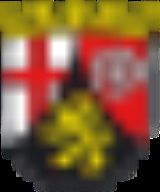
Coat of arms of Rhineland-Palatinate
Encyclopedia
This article is about the coat of arms
of the German
state of Rheinland-Pfalz
(Rhineland-Palatinate).
The state flag and the coat of arms were designed in 1947 after this new Land was formed by the authority of the French High Commissioner to Germany. The flag symbolizes the dedication of Rhineland-Palatinate to Germany (therefore the black-red-gold tricolour) as well as the democratic traditions of Germany. These colours were seen first in this combination during the Hambacher Fest, a mass demonstration by german liberals at the ruins of the Hambacher Schloss
in 1832. So the Palatinate is very much connected to these colours.
The coat of arms, which is also an integral part of the state flag, shows the signs of the predominant powers in the region before the French Revolution:
the red cross on silver represents the Archbishop and Kurfürst (Prince Elector) of Trier; the silver wheel on red represents the Archbishop and Prince Elector of Mainz
, and the golden lion on black represents the Prince Elector of the Palatinate.
The Volkskrone (people's crown) consists of leaves of wine and shows the importance of this good for the local agriculture.
Coat of arms
A coat of arms is a unique heraldic design on a shield or escutcheon or on a surcoat or tabard used to cover and protect armour and to identify the wearer. Thus the term is often stated as "coat-armour", because it was anciently displayed on the front of a coat of cloth...
of the German
Germany
Germany , officially the Federal Republic of Germany , is a federal parliamentary republic in Europe. The country consists of 16 states while the capital and largest city is Berlin. Germany covers an area of 357,021 km2 and has a largely temperate seasonal climate...
state of Rheinland-Pfalz
Rhineland-Palatinate
Rhineland-Palatinate is one of the 16 states of the Federal Republic of Germany. It has an area of and about four million inhabitants. The capital is Mainz. English speakers also commonly refer to the state by its German name, Rheinland-Pfalz ....
(Rhineland-Palatinate).
The state flag and the coat of arms were designed in 1947 after this new Land was formed by the authority of the French High Commissioner to Germany. The flag symbolizes the dedication of Rhineland-Palatinate to Germany (therefore the black-red-gold tricolour) as well as the democratic traditions of Germany. These colours were seen first in this combination during the Hambacher Fest, a mass demonstration by german liberals at the ruins of the Hambacher Schloss
Hambach Castle
Hambach Castle near the urban district Hambach of Neustadt an der Weinstraße in Rhineland-Palatinate, Germany, is considered to be the symbol of the German democracy movement because of the Hambacher Fest which occurred here in 1832.- Location :...
in 1832. So the Palatinate is very much connected to these colours.
The coat of arms, which is also an integral part of the state flag, shows the signs of the predominant powers in the region before the French Revolution:
the red cross on silver represents the Archbishop and Kurfürst (Prince Elector) of Trier; the silver wheel on red represents the Archbishop and Prince Elector of Mainz
Archbishopric of Mainz
The Archbishopric of Mainz or Electorate of Mainz was an influential ecclesiastic and secular prince-bishopric in the Holy Roman Empire between 780–82 and 1802. In the Roman Catholic Church hierarchy, the Archbishop of Mainz was the primas Germaniae, the substitute of the Pope north of the Alps...
, and the golden lion on black represents the Prince Elector of the Palatinate.
The Volkskrone (people's crown) consists of leaves of wine and shows the importance of this good for the local agriculture.
Legal status
See also
- Coat of arms of PrussiaCoat of arms of PrussiaThe state of Prussia developed from the State of the Teutonic Order. The original flag of the Teutonic Knights had been a black cross on a white flag.Emperor Frederick II in 1229 granted them the right to use the black Eagle of the Holy Roman Empire....
- Coat of arms of GermanyCoat of arms of GermanyThe coat of arms of Germany displays a black eagle on a yellow shield ....
- Origin of the coats of arms of German federal states.

